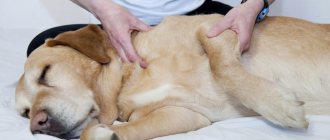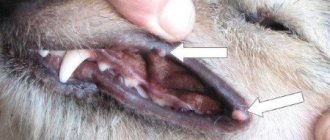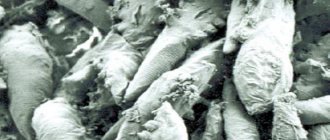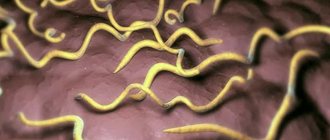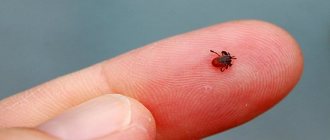Joint diseases significantly limit a dog’s capabilities and often lead to dire consequences. One of these dangerous diseases is bursitis, which can occur in dogs at any age. Elderly individuals, who are characterized by the most severe forms of bursitis, are most prone to this disease. The disease itself is quite easy to recognize externally by the characteristic lump that usually appears in the area of the animal’s elbows or knees. Read on to learn more about what bursitis is in dogs and how it is treated.
Bursitis in dogs: symptoms and treatment
What is bursitis?
Bursitis refers to inflammation and subsequent swelling of the so-called synovial bursa. Each train is equipped with such a bag, since it serves as a kind of airbag filled with a special liquid. The bursa prevents various injuries and also helps reduce the friction that occurs between the joint, tendons and muscles.
Bursitis causes inflammation of the special sac that protects the joint from damage.
There are many synovial bursae in a dog's body, but in most cases, veterinarians note that the bursae that protect the elbow and knee joints are most susceptible to inflammation.
The rate of development of the disease and its consequences
Bursitis poses an immediate danger to the dog's life, since it can immobilize it in the shortest possible time. In addition, this disease affects the well-being of the animal as a whole, striking a blow to the nervous system. Sometimes bursitis only takes two weeks to “take away” your pet’s limbs. The disease can affect one or several paws of an animal.
The rate of development of bursitis depends on its shape
However, this pathology is not incurable and can be corrected: if you contact a veterinarian in a timely manner, the animal can be saved through surgery.
Causes
Despite the fact that bursitis has long been known to all veterinarians, the reasons for its occurrence remain unclear. Therefore, most experts prefer to talk about the general weakening of the dog’s health, as a result of which it becomes susceptible to various ailments. The following factors can provoke bursitis:
- protracted infectious diseases;
- joint injuries experienced by the dog (both in the long and recent past);
- autoimmune pathologies such as lupus, pemphigus, rheumatoid polyarthritis, etc.;
- undiagnosed allergy to any irritant;
- excessive physical activity that exhausts the animal.
Individuals whose bodies are in an exhausted state are predisposed to bursitis.
From the above list we can conclude that it is impossible to completely protect a dog from the occurrence of bursitis. However, monitoring the animal’s health and scheduled visits to the veterinarian will reduce the risk of developing this pathology to a minimum.
Risk group
If we talk about animals most susceptible to bursitis, it is worth noting all large breed dogs. In addition to a sometimes weak heart and problematic circulatory system, representatives of large breeds periodically experience complications associated with joints. Moreover, sometimes bursitis goes so far that the owners of sick animals can only euthanize their pets due to the fact that their hind legs are failing.
Large individuals are more likely to develop bursitis than their miniature relatives.
Among the breeds predisposed to bursitis, we note several main ones:
- Caucasian Shepherd Dog;
- Tibetan mastiff;
- Labrador;
- Saint Bernard;
- Leonberger;
- Newfoundland.
Chihuahuas, Yorkshires, Havanese Bichons and other “pocket dogs” suffer from bursitis extremely rarely, since the musculoskeletal system undergoes much less stress.
Reasons for appearance
Bursitis in dogs can be either a consequence of improper care for the dog or a complication of any disease. The exact cause of the pathology is not clear.
The main reasons for the appearance include:
- hypothermia, as a result of which blood flow in the external and internal tissues of the animal is disrupted;
- allergic reactions, which manifest themselves as rashes and itching;
- damage and repeated injuries to the paws;
- an infection inside the synovial bursa, which promotes the rapid proliferation of microbes that feed on the fluid filling it;
- weakened immune system due to poor nutrition;
- the breed's predisposition to bursitis;
- excessive physical activity, constant training, especially before exhibitions or during service.
In addition, cases of bursitis have been recorded in dogs with incorrectly selected bedding. If it is too hard or, as in the case of watchdogs, the animal sleeps on the ground, over time the process of degeneration begins in the tissues, the walls of the synovial bursa thicken, and exudate accumulates in it.
The material from which the bed is made can also affect the dog’s health. Foam rubber bedding absorbs sweat well, but has almost no heat transfer, which can lead to hypothermia for your pet.
Types of Bursitis
There are several types of bursitis, depending on the classification approach. Based on clinical manifestations, veterinarians divide bursitis into:
- aseptic;
- spicy;
- chronic.
Acute forms of bursitis are more typical for a disease affecting the elbow joints. Hock bursitis can go unnoticed for a long time and be accompanied by only minor lameness after walking or vigorous physical activity.
Inside the bursa there is exudate mixed with blood.
Aseptic bursitis, in turn, can occur in different ways, depending on its subtype:
- serous;
- serous-fibrous;
- fibrinous;
- ossifying.
This classification is based on the type of fluid (or exudate) that has accumulated in the inflamed bursa.
There is another division, based on the presence or absence of purulent processes in the bursa and numbering only two types of bursitis:
- aseptic is more typical for closed joint wounds and is not accompanied by the penetration of pus from the outside. More often found in dogs with problems with the immune system;
- purulent is characterized by the occurrence of suppuration in the synovial bursa and rapid progression. As a rule, it occurs in old individuals, which in most cases are then euthanized so as not to cause suffering to the animal.
The purulent type of bursitis is more often observed with damage to the elbow joints
Sometimes there is such a phenomenon as false bursitis, which leads to the formation of a lump, but does not cause any discomfort to the animal and does not hinder movement.
Treatment of elbow bursitis in dogs
If bursitis is suspected, treatment should be carried out immediately. To do this, you need a full examination of the animal by a veterinarian and collection of the necessary tests. After which the degree and form of the disease is determined and appropriate treatment is prescribed. Treatment is usually quite conservative, and surgery is extremely rare. At the initial stage, the animal should be given maximum rest and immobility, any physical activity and long walks should be stopped for the duration of treatment.
The doctor should attach a special bandage or elbow pad to the affected joint. In the first days of treatment, you need to apply cold lotions with an anesthetic or disinfectant. After 2-3 days, cold lotions are replaced by warm compresses. All treatment can be carried out at home.
If the form of the disease has become more complex, the dog’s bursitis must be treated in a hospital, with constant examination by a doctor. For treatment, lamp irradiation, ointments with an antibacterial effect, as well as ointments based on potent antibiotics are used. If the doctor detects the presence of pus, it is pumped out using a special syringe. After that, an injection of hydrocortisone is given into the synovial bursa of the joint, which disinfects and heals.
Symptoms
Since there are both acute and chronic varieties of bursitis, its symptoms can take different forms. Acute bursitis is more typical for the purulent form and poses a threat to the dog, while chronic bursitis may not last for many months, causing the dog significant discomfort.
Dogs with bursitis lose interest in the world around them.
Common symptoms characteristic of all types of bursitis include:
- the appearance of a “tumor” as a result of a change in the outline of the joint: in simple terms, a lump forms on the animal’s knee or elbow. The reason for the appearance of such a lump is swelling of the walls of the synovial bursa and its increase due to the ingress of exudate. To the touch, such a neoplasm is not solid; there is liquid inside it;
The resulting lump can be either neutral or hot to the touch
- decreased mobility, lameness, paw tightening. Dogs always react painfully to neoplasms of this kind, becoming much less active. If the disease becomes chronic, then over time bridges appear on the animal’s elbows, and the accumulated liquid acquires a yellowish tint;
- fistula formation. Fistulas are characteristic of the purulent type of bursitis, which occurs in an acute form, since pus begins to be released from such canals. When fistulas appear, the lump usually takes on a darker shade;
Lameness is the first warning sign of bursitis
- general depressed state. As already mentioned, bursitis affects the animal’s body as a whole, therefore a sick dog loses its appetite, as a result of which the pet loses weight. He loses interest in walks and movement as such, preferring a recumbent lifestyle.
Without the help of a veterinarian, this pus-filled mass will eventually burst open. As a result, either pus or ichor mixed with blood flows out of the bag. Opening the synovial bursa is dangerous not only due to damage to the limbs, but also due to infection in the open wound.
What diseases can be confused with?
In the early stages of development, bursitis is easy to confuse, despite the fact that its symptoms are visible to the naked eye. In terms of symptoms, this disease is in many ways similar to two serious diseases - dysplasia and arthritis.
Dysplasia
Like bursitis, dysplasia mainly affects large animals and is considered a hereditary disease, and can also be caused by growth promoters fed to show animals. The cause of dysplasia is a disproportionate increase in muscles and bones (in which muscles develop faster).
Unfortunately, modern medicine can only slow down the development of dysplasia, but not cure it
Arthritis
Arthritis occurs as a result of inflammation of the joint, causing the animal to limp and stiffen the affected limb. If a purulent type of the disease occurs, the dog also develops fistulas from which exudate oozes. Like bursitis, arthritis can lead to death or amputation if the disease is severe.
Comparison of the bones of a healthy dog and a dog with arthritis
Symptoms of tumor appearance
If we talk about acute bursitis, its main symptoms are: swelling in the bend of the joint, this swelling is hotter to the touch than the rest of the animal’s body;
- severe pain when moving, the dog may whine and lean more
- on healthy paws, squeezing the sick one;
- severe pain is felt at night;
- lameness, sometimes the animal tries to move less;
- Sometimes a purulent formation may form in the swelling. The cone becomes very dark.
By quickly identifying bursitis in a dog, you can prevent the disease from becoming chronic, thereby relieving pain symptoms and removing swelling in the joints. False (or chronic) bursitis is a form of disease in which a lump or swelling appears on the dog’s joints, but does not cause him any pain and does not make it difficult for him to move.
First aid for an animal
Since it is not so easy to identify bursitis, self-medication of the animal is completely pointless. Only a veterinarian can make an accurate diagnosis after a detailed examination of the dog and an x-ray. If moving causes severe pain to your pet, it is advisable to call a specialist to your home. This service is more expensive than visiting a veterinary clinic on your own, but often it is the only possible solution.
A sick animal should never sleep or rest on the bare floor.
Before the veterinarian sees the animal, it is necessary to ensure that it is as comfortable as possible. To create such conditions, the owner will need:
- stop any training or active play with the dog if he has not done so before;
- provide the animal with soft and voluminous bedding to prevent the swollen joint from coming into contact with the hard, cold floor;
- eliminate all possible drafts;
- refuse any compresses. If a compress can be useful for the aseptic form of bursitis, then for purulent bursitis it can only harm the dog, contributing to the occurrence of sepsis;
- If fistulas occur, do not under any circumstances try to remove pus oozing from the affected area.
If your dog is showing signs of bursitis, you should take him to the vet as soon as possible.
Even if the animal’s lameness is not noticeable and does not lead to visible changes, it is advisable to consult a doctor as quickly as possible, since the acute form can develop in just a few days. The sooner the owner involves a veterinarian, the higher the chance of saving the dog.
Preventive measures
To avoid such an unpleasant disease as bursitis, you need to follow some rules that will protect your pet. Among them:
- good living conditions (the dog should not sleep in a cold place or in a draft);
- the place to sleep should be soft and warm (it is undesirable for the dog to sleep on cold tiles or linoleum), avoid dampness in the room where the animal is located;
- for large breeds, the diet must contain chondroitin,
- glucosamine and other supplements that affect good joint function; dry food or food must be balanced and appropriate for the weight and characteristics of the animal. Food should contain plenty of grains and protein products. Do not use fatty foods and bones in your diet;
- physical activity as the dog ages. Even large breeds should not get carried away with activities that involve overcoming high barriers. Combine active games and long walks. In the cold and damp seasons, avoid walking in the rain, and also ensure that the dog does not become hypothermic.
Bursitis in dogs is a disease that requires immediate treatment and sometimes surgery. And although the consequences after treatment are not always positive, with proper care the dog will feel comfortable for a long time. To avoid disease, you need to follow the recommendations of a specialist and properly care for the animal. But if you notice symptoms of the disease, you should immediately consult a doctor. Remember that home treatment can only make the problem worse.
Sources:
https://sobaki-pesiki.ru/bursit-loktevogo-i-kolennogo-sustava-u-sobak.html https://fb.ru/article/411397/bursit-u-sobak-prichinyi-simptomyi-metodyi-lecheniya -sovetyi-veterinarov https://realpet.ru/zdorovie/bursit-u-sobak.html
Treatment
Treatment methods for bursitis depend on how far the disease has progressed and what specific form is observed in the animal. If bursitis can be identified in the initial stages, then, most likely, it can be cured without surgical intervention, limiting itself to conservative methods.
Treatment of bursitis in the early stages
Conservative methods of treating bursitis include the following procedures:
- the veterinarian applies a pressure bandage to the animal’s paw, which allows you to fix the limb and not cause additional pain to the dog;
- The animal is prescribed cold compresses: they will constrict the blood vessels and thus reduce blood flow to the inflamed area. After a few days, cold compresses are replaced by hot ones (which are not allowed to be used for purulent bursitis);
A cold compress consists of several layers of fabric and allows you to evenly treat the affected part of the body
- Some experts also advise using infrared lamps in treatment using a Sollux lamp. It is prescribed as an alternative or addition to hot compresses and has a similar effect;
- in case of a chronic course, special irritating ointments are prescribed, as well as iodine iontophoresis, which is carried out in a clinic and involves connecting a small current;
The use of currents allows you to relieve inflammation and restore the diseased limb
- after opening the fistula (if any), the dog must undergo a course of broad-spectrum antibiotics, which will not allow pathogenic bacteria to penetrate the open wound.
You can read more about how to make a hot compress for a dog below.
Making a compress for a dog
Surgical intervention
As you might guess, surgical intervention is prescribed for advanced stages of bursitis, when conservative therapy is powerless. The procedure involves cleansing the bursa and includes the following steps:
- the surgeon opens the bag and removes from it the remains of pus, exudate and dead flesh;
- the skin at the site of inflammation is sutured in such a way that the empty bag does not interfere with the dog’s movement;
- if the joint has been significantly destroyed, some clinics replace it with an implant made of plastic or titanium. Unfortunately, this procedure is quite expensive and is rarely practiced in Russia.
Surgeries are performed on dogs mainly in advanced stages of bursitis.
Important! At the end of the operation, it is advisable to give the dog time to recover in a hospital setting, where the animal usually receives hydrocortisone injections over the next week.
Unfortunately, not all operations to empty the synovial sac end well. It also happens that, despite the removal of the bursa, inflamed areas of skin remain in the dog’s body, which again make themselves felt after the suture heals. In this case, the dog’s condition worsens again, and it requires a second operation, which will be much more difficult for the animal to endure.
Fistulas are the most dangerous variant of the development of the disease
Video - Bursitis: symptoms and treatment
Methods for treating bursitis in dogs
If the accumulation of fluid in the joint capsule occurs in a young dog (up to 1-1.5 years), and this phenomenon does not bother her in any way, no measures should be taken. This kind of bursitis will most likely go away on its own after your pet grows up.
If the development of the disease was caused by injury or infection, it must be treated. There are two ways to combat this disease: conservative and surgical.
Conservative treatment
This method involves the use of ointments, tablets and injections.
Treatment begins with the removal of fluid.
Here is a scheme that will cure your pet from bursitis:
- The hair on the affected area is shaved.
- Fluid is pumped out of the joint capsule (to do this, a sterile needle from a syringe is carefully inserted into the bursitis, after which exudate will begin to flow out of it).
- The bursa cavity is washed, hormonal drugs (Kenolog, Prednisolone, Hydrocortisone, etc.) are administered inside according to a regimen approved by a veterinarian.
- If pus accumulates in the synovial bursa, an antibiotic is administered along with hormonal drugs (it is selected by a specialist).
- In the early stages of bursitis, when there is still no pus in the cavity, Vishevsky ointment is applied to the affected area and warm compresses are made.
- Due to hormones, the pet’s immunity suffers, so to strengthen it, immunostimulants are used according to the scheme (Roncolein, Immunofan, etc.).
Recovery
If the owner closely monitors the condition of the recovering dog, final recovery may take from a couple of weeks to a month and a half, depending on the severity of the disease. Pain and swelling go away in the first days, however, even after significant improvement, the owner must not lose vigilance: healing of the joint takes time and patience.
Dog with a bandage on the elbow joint
Most likely, the veterinarian will prescribe a special brace for the dog (especially if it has had fistulas), which will fix the position of the limb in the correct way. Under no circumstances should this corset be removed from the animal ahead of time, even if it interferes with the dog, or if the owner seems that his pet has already recovered. Aseptic bursitis goes away in two to four weeks, while purulent bursitis requires treatment for five to six weeks.
Strengthening the immune system
Regardless of whether the pet has undergone surgery or not, most specialists, along with a corset and compresses, prescribe immunomodulators that will help strengthen a weakened immune system. The most popular immunomodulators these days are presented in the table below.
Table. Immunomodulators for dogs
| Name | Method of administration | Description |
"Glycopin" | Oral (tablets) | This product has a wide spectrum of action and is used for many pets. The drug is effective in the treatment of various inflammatory processes (both chronic and acute). It has no significant side effects, but veterinarians do not recommend giving it to females during pregnancy. For dogs weighing more than twenty kilograms, it is enough to take one tablet per day for 4-5 days |
"Ribotan" | Subcutaneous or intramuscular (injection) | A transparent solution containing low molecular weight peptides and fragments of yeast RNA. Accelerates the regeneration of the body and has an antitoxic effect. Used for both preventive and therapeutic purposes. Available in ampoules of different sizes. For dogs, depending on their size, 1 to 2 ml of the substance is instilled at a time |
"Maksidin" | Subcutaneous or intramuscular (injection) | “Maksidin” is most suitable for dogs with bursitis, since it not only provides general support to the body, but also provides an antitumor effect. The drug promotes the production of interferon in large quantities, which helps protect the animal's open wound from various viruses. An injection is given to a sick animal twice a day for five days. |
"Gamavit" | Intramuscular (injections) | A complex immunomodulator used by dog breeders for a variety of purposes - from helping a dog recover after surgery to preventing toxicosis. The drug is administered no more than three times a day for five days for therapeutic purposes. For preventive purposes, “Gamavit” is also used orally, by feeding the pet |
You can read more information about Gamavit
You can also add vitamins to your dog's diet, but only after consulting a doctor.
Conservative and surgical treatment methods
Surgical intervention is resorted to in exceptional cases. Most hygromas can be cured with conservative therapy, the basis of which is the elimination of the etiological factor. To prevent re-injury, dogs are given soft bedding and strong physical activity (work, training) is avoided.
To treat uncomplicated bursitis, it is enough to change the content - soft bedding should restore the function of the joint.
Aseptic hygroma usually does not require treatment. The owner should change the approach to keeping the dog - provide the dog with a comfortable and soft bed. In some cases, a bandage is also applied to the affected joint. Recovery and disappearance of symptoms is observed within 2-3 weeks.
The first step in therapy is to eliminate the etiological factor to avoid further injury. During the rehabilitation period, it is better to isolate the dog in a room with soft bedding or place beds in the pet’s favorite resting places. The bedding is left even after recovery, as relapses are possible.
Commercial elbow pads are now available to immobilize the elbow joint and protect it from external forces. Such devices are easily fixed on the animal, adapting to individual characteristics. Most dogs can easily tolerate joint pads.
To reduce exudation in the first days of the pathological process, it is recommended to apply ice, make alcohol lotions and tight bandages.
In the future, they switch to warming procedures to speed up recovery processes. The dogs are given a massage of the surrounding tissues, warming bandages and heating pads are applied. They rub in irritating substances and make applications of ozokerite and clay.
Aspiration of exudate from the synovial bursa most often turns out to be ineffective - after pumping out, the bursa gradually fills up again. This can be useful in purulent forms. In this case, after aspiration of the pus, it is necessary to rinse the cavity with an antiseptic solution.
Surgery is usually resorted to only after unsuccessful therapeutic treatment. A drainage is installed for prompt drainage of exudate, and antimicrobial therapy is prescribed. Fixing and protective bandages are applied to the limbs. Treatment is carried out until scar tissue forms, which prevents the re-formation of bursitis. But often such treatment leads to impaired motor activity.
If purulent bursitis is accompanied by the formation of a fistula, then it is necessary to remove the pathological contents. The cavity is examined for the presence of pockets filled with pus. The wound is washed with hydrogen peroxide, potassium permanganate or other antiseptic solution. Antibiotics and sulfonamides are placed in the cavity, and they are also used in systemic form.
Otherwise, they make surgical access to the pathological cavity and proceed in the same way. To prevent the edges of the wound from closing, drainage is installed for the free outflow of exudate. At the same time, general measures are taken to treat aseptic bursitis in order to reduce the inflammatory and exudative reaction. Treatment is carried out until the purulent process is completely eliminated. After which the wound is sutured, and the animal’s condition is constantly monitored to avoid relapses and complications.
Features of prevention
To prevent bursitis, it is necessary to combat predisposing factors, this is especially true for owners of large dogs. First of all, good living conditions are created:
- spacious enclosure;
- soft bedding, which is changed regularly;
- walking the animal, providing physical activity.
An important point is feeding control. In obese dogs, hygroma develops significantly more often. Excess body weight puts excessive pressure on the joint capsule. It is better to learn about proper nutrition for your pet from a veterinarian so that he can select an individual diet that takes into account the breed, age and weight of the animal.
In most cases, bursitis in dogs can be cured without surgical measures. Timely contacting a veterinary clinic and proper treatment allows the animal to recover quickly. The owner must play a large role in therapy - it is necessary to create high-quality conditions for keeping the pet in order to avoid repeated injuries.
Bursitis in dogs is an inflammation of the periarticular (synovial) bursa, occurring acutely or chronically. Anatomically, the synovial bursa (bursa) is a small closed cavity filled with viscoelastic synovial fluid that serves to lubricate the joint. Bursae are located between tendons and ligaments, as well as in places where tendons rub against bone, acting as a protective pad.
